
Photo from wikipedia
Abstract Little is known about the effects of glacier-air interactions on the Himalayan glacier mass balance. Until this knowledge gap is filled, a reliable projection of the future changes in… Click to show full abstract
Abstract Little is known about the effects of glacier-air interactions on the Himalayan glacier mass balance. Until this knowledge gap is filled, a reliable projection of the future changes in the Himalayan glaciers is hardly possible. Here, we describe the drying effect of the katabatic winds on the up-valley summer monsoon flows by creating favorable conditions for local convergence-induced precipitation to occur near the glacier fronts. We postulate that this retarding effect on the up-valley monsoon flows results in a negative feedback mechanism mediated by glacier-air interactions, in which glacial retreat pushes precipitation upwards as the down-valley katabatic winds weaken, resulting in greater local precipitation and enhanced snow accumulation across the upper parts of the Himalayan glaciers. Our analyses are based on the exclusive data recorded in the Khumbu valley and the Langtang valley in the Nepalese Himalayas. These data revealed higher afternoon precipitation in summer associated with surface wind convergence near the glacier fronts and a sharp decrease in the temperature lapse rate over the glacier surfaces. The principle of the observed phenomena was proven by our high-resolution modeling sensitive experiment, which involved two simulations, one with the present glaciers and the other without. This numerical experiment also supports the proposed negative feedback. Furthermore, we report a low deuterium excess near the glacier fronts, indicating below-cloud re-evaporation facilitated by the local convergence induced by the dry katabatic winds. Our study suggests that current models may overestimate the retreat of Himalayan glaciers because they have completely ignored the glacier-air interactions.
Journal Title: Atmospheric Research
Year Published: 2021
Link to full text (if available)
Share on Social Media: Sign Up to like & get
recommendations!